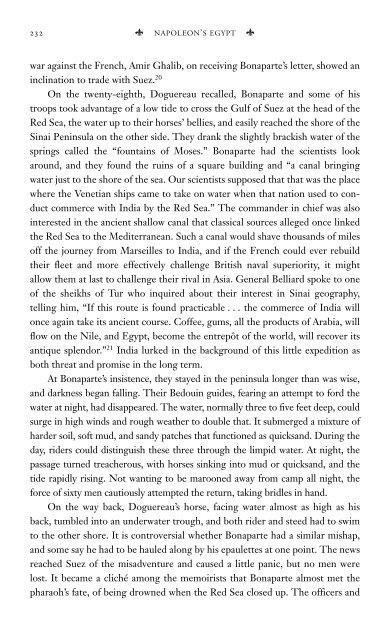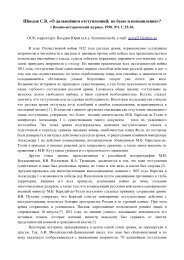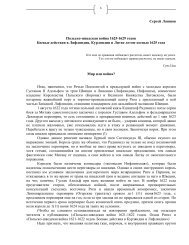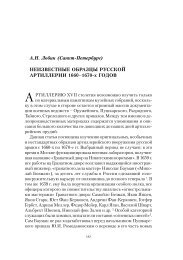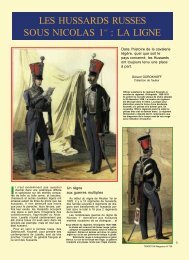- Page 2 and 3:
Napoleon’s EgyptINVADING THE MIDD
- Page 4 and 5:
Napoleon’s EgyptINVADING THE MIDD
- Page 6 and 7:
CONTENTSMap of EgyptList of Illustr
- Page 8 and 9:
Map by Arman H. Cole
- Page 10 and 11:
ACKNOWLEDGMENTSNapoleon’s Egypt c
- Page 12 and 13:
ACKNOWLEDGMENTSxiBrettne Bloom and
- Page 14 and 15:
Napoleon’s EgyptINVADING THE MIDD
- Page 16 and 17:
1THE GENIUS OF LIBERTYThe top-secre
- Page 18 and 19:
THE GENIUS OF LIBERTY3the Continent
- Page 20 and 21:
THE GENIUS OF LIBERTY5in the mounta
- Page 22 and 23:
THE GENIUS OF LIBERTY7The quarterma
- Page 24 and 25:
THE GENIUS OF LIBERTY9would take a
- Page 26 and 27:
THE GENIUS OF LIBERTY11Egypt, where
- Page 28 and 29:
THE GENIUS OF LIBERTY13Throughout t
- Page 30 and 31:
THE GENIUS OF LIBERTY15Revolution i
- Page 32 and 33:
THE GENIUS OF LIBERTY17That April,
- Page 34 and 35:
THE GENIUS OF LIBERTY19course, the
- Page 36 and 37:
2A SKY AFLAMEThe patrician Vice Adm
- Page 38 and 39:
A SKY AFLAME23Bernoyer reported tha
- Page 40 and 41:
A SKY AFLAME25defeat, but this defi
- Page 42 and 43:
A SKY AFLAME27horse. Moiret, and th
- Page 44 and 45:
A SKY AFLAME29about Cleopatras. To
- Page 46 and 47:
A SKY AFLAME31vocabulary. The procl
- Page 48 and 49:
A SKY AFLAME33fore and killed him,
- Page 50 and 51:
A SKY AFLAME35out a governor or vic
- Page 52 and 53:
A SKY AFLAME37most elegantly explai
- Page 54 and 55:
A SKY AFLAME39Damanhur. “In five
- Page 56 and 57:
A SKY AFLAME41Adj. Gen. Augustin-Da
- Page 58 and 59:
A SKY AFLAME43his journal for 11 Ju
- Page 60 and 61:
3THE FERMENT OF THE MINDThe French
- Page 62 and 63:
THE FERMENT OF THE MIND47with this
- Page 64 and 65:
THE FERMENT OF THE MIND49saw Ottoma
- Page 66 and 67:
THE FERMENT OF THE MIND51so as to e
- Page 68 and 69:
THE FERMENT OF THE MIND53carbine (a
- Page 70 and 71:
THE FERMENT OF THE MIND55governors
- Page 72 and 73:
THE FERMENT OF THE MIND57consistent
- Page 74 and 75:
THE FERMENT OF THE MIND59were gathe
- Page 76 and 77:
THE FERMENT OF THE MIND61shown the
- Page 78 and 79:
THE FERMENT OF THE MIND63Shum, 1,80
- Page 80 and 81:
4GRAND CAIROHungry, thirsty, and ex
- Page 82 and 83:
GRAND CAIRO67ranks, the opposing ca
- Page 84 and 85:
GRAND CAIRO69Moreover, French artil
- Page 86 and 87:
GRAND CAIRO71enty-five city quarter
- Page 88 and 89:
GRAND CAIRO73Bonaparte had Cairo, a
- Page 90 and 91:
GRAND CAIRO75ment, and received for
- Page 92 and 93:
GRAND CAIRO77the latest in a long l
- Page 94 and 95:
GRAND CAIRO79tians had a superstiti
- Page 96 and 97:
GRAND CAIRO81nate curiosity; they s
- Page 98 and 99:
GRAND CAIRO83Desvernois observed of
- Page 100 and 101:
5THE FLIGHT OF IBRAHIM BEYLeclerc
- Page 102 and 103:
THE FLIGHT OF IBRAHIM BEY87hands.
- Page 104 and 105:
THE FLIGHT OF IBRAHIM BEY89vations
- Page 106 and 107:
THE FLIGHT OF IBRAHIM BEY91French o
- Page 108 and 109:
THE FLIGHT OF IBRAHIM BEY93commande
- Page 110 and 111:
THE FLIGHT OF IBRAHIM BEY95interced
- Page 112 and 113:
THE FLIGHT OF IBRAHIM BEY97even tho
- Page 114 and 115:
THE FLIGHT OF IBRAHIM BEY99his trea
- Page 116 and 117:
THE FLIGHT OF IBRAHIM BEY101Bonapar
- Page 118 and 119:
THE FLIGHT OF IBRAHIM BEY103“Many
- Page 120 and 121:
THE FLIGHT OF IBRAHIM BEY105Bonapar
- Page 122 and 123:
6THE MOST BEAUTIFUL NILETHAT HAS EV
- Page 124 and 125:
THE MOST BEAUTIFUL NILE THAT HAS EV
- Page 126 and 127:
THE MOST BEAUTIFUL NILE THAT HAS EV
- Page 128 and 129:
THE MOST BEAUTIFUL NILE THAT HAS EV
- Page 130 and 131:
THE MOST BEAUTIFUL NILE THAT HAS EV
- Page 132 and 133:
THE MOST BEAUTIFUL NILE THAT HAS EV
- Page 134 and 135:
THE MOST BEAUTIFUL NILE THAT HAS EV
- Page 136 and 137:
THE MOST BEAUTIFUL NILE THAT HAS EV
- Page 138 and 139:
7ALI BONAPARTEAlthough he was being
- Page 140 and 141:
ALI BONAPARTE125When evening fell,
- Page 142 and 143:
ALI BONAPARTE127posed to the infide
- Page 144 and 145:
ALI BONAPARTE129Muslims who drank w
- Page 146 and 147:
ALI BONAPARTE131forces sufficient t
- Page 148 and 149:
ALI BONAPARTE133that “the politic
- Page 150 and 151:
ALI BONAPARTE135Menou wrote in Octo
- Page 152 and 153:
ALI BONAPARTE137her as often as pos
- Page 154 and 155:
ALI BONAPARTE139bride, with “‘A
- Page 156:
ALI BONAPARTE141volved what to them
- Page 159 and 160:
144 NAPOLEON’S EGYPThundred Bedou
- Page 161 and 162:
146 NAPOLEON’S EGYPTscientists an
- Page 163 and 164:
148 NAPOLEON’S EGYPTDetroye saw o
- Page 165 and 166:
150 NAPOLEON’S EGYPTThe commander
- Page 167 and 168:
152 NAPOLEON’S EGYPTbut also in I
- Page 169 and 170:
154 NAPOLEON’S EGYPTlight artille
- Page 171 and 172:
156 NAPOLEON’S EGYPTreforming, li
- Page 173 and 174:
158 NAPOLEON’S EGYPTdistrict, but
- Page 175 and 176:
160 NAPOLEON’S EGYPTfollow regula
- Page 177 and 178:
162 NAPOLEON’S EGYPTThe lake peop
- Page 179 and 180:
164 NAPOLEON’S EGYPTGeneral Vial
- Page 181 and 182:
166 NAPOLEON’S EGYPTThe French ex
- Page 183 and 184:
168 NAPOLEON’S EGYPTrevolutionary
- Page 185 and 186:
170 NAPOLEON’S EGYPTmillion citiz
- Page 187 and 188:
172 NAPOLEON’S EGYPTnew Egypt for
- Page 189 and 190:
174 NAPOLEON’S EGYPTfor republica
- Page 191 and 192:
176 NAPOLEON’S EGYPTDoguereau des
- Page 193 and 194:
178 NAPOLEON’S EGYPTLater he happ
- Page 195 and 196: 180 NAPOLEON’S EGYPTFrench slave
- Page 197 and 198: 182 NAPOLEON’S EGYPTTheir nervous
- Page 199 and 200: 184 NAPOLEON’S EGYPTits saint ins
- Page 201 and 202: 186 NAPOLEON’S EGYPTfanatical”
- Page 203 and 204: 188 NAPOLEON’S EGYPThowever, this
- Page 205 and 206: 190 NAPOLEON’S EGYPTand a cape of
- Page 207 and 208: 192 NAPOLEON’S EGYPTWives of comm
- Page 209 and 210: 194 NAPOLEON’S EGYPTpersuaded to
- Page 211 and 212: 196 NAPOLEON’S EGYPTmistress migh
- Page 213 and 214: 198 NAPOLEON’S EGYPTalong major t
- Page 215 and 216: 200 NAPOLEON’S EGYPTthe chief jus
- Page 217 and 218: 202 NAPOLEON’S EGYPTammunition fr
- Page 219 and 220: 204 NAPOLEON’S EGYPTnear the Gran
- Page 221 and 222: 206 NAPOLEON’S EGYPTto see Bonapa
- Page 223 and 224: 208 NAPOLEON’S EGYPTwere threaten
- Page 225 and 226: 210 NAPOLEON’S EGYPTHe was hit by
- Page 227 and 228: 212 NAPOLEON’S EGYPTThe morning o
- Page 229 and 230: 214 NAPOLEON’S EGYPThad been drag
- Page 231 and 232: 216 NAPOLEON’S EGYPTrevolt,” ac
- Page 233 and 234: 218 NAPOLEON’S EGYPTBonaparte of
- Page 235 and 236: 220 NAPOLEON’S EGYPTFrench occupa
- Page 237 and 238: This page intentionally left blank
- Page 239 and 240: 224 NAPOLEON’S EGYPTburned by us;
- Page 241 and 242: 226 NAPOLEON’S EGYPTthe populatio
- Page 243 and 244: 228 NAPOLEON’S EGYPTdefeated and
- Page 245: 230 NAPOLEON’S EGYPTBonaparte hel
- Page 249 and 250: 234 NAPOLEON’S EGYPTone. The tech
- Page 251 and 252: 236 NAPOLEON’S EGYPTthick, his sw
- Page 253 and 254: 238 NAPOLEON’S EGYPTMarmont acted
- Page 255 and 256: 240 NAPOLEON’S EGYPTconducted a f
- Page 257 and 258: 242 NAPOLEON’S EGYPTThe Meccan vo
- Page 259 and 260: 244 NAPOLEON’S EGYPTnearly 6,000
- Page 261 and 262: 246 NAPOLEON’S EGYPTperhaps for t
- Page 263 and 264: 248 NAPOLEON’S EGYPTEastern resis
- Page 265 and 266: This page intentionally left blank
- Page 267 and 268: 252 NAPOLEON’S EGYPT12. François
- Page 269 and 270: 254 NAPOLEON’S EGYPT14. Napoléon
- Page 271 and 272: 256 NAPOLEON’S EGYPT19. Pelleport
- Page 273 and 274: 258 NAPOLEON’S EGYPT30. Napoléon
- Page 275 and 276: 260 NAPOLEON’S EGYPT(27 July 1798
- Page 277 and 278: 262 NAPOLEON’S EGYPT8. Napoléon
- Page 279 and 280: 264 NAPOLEON’S EGYPT18. Alan Scho
- Page 281 and 282: 266 NAPOLEON’S EGYPTCollections O
- Page 283 and 284: 268 NAPOLEON’S EGYPT38. Napoléon
- Page 285 and 286: 270 NAPOLEON’S EGYPT14. Pierre Mi
- Page 287 and 288: This page intentionally left blank
- Page 289 and 290: 274 NAPOLEON’S EGYPTBerhollet, Cl
- Page 291 and 292: 276 NAPOLEON’S EGYPTTubar and, 16
- Page 293 and 294: 278 NAPOLEON’S EGYPTPelleport, Pi


